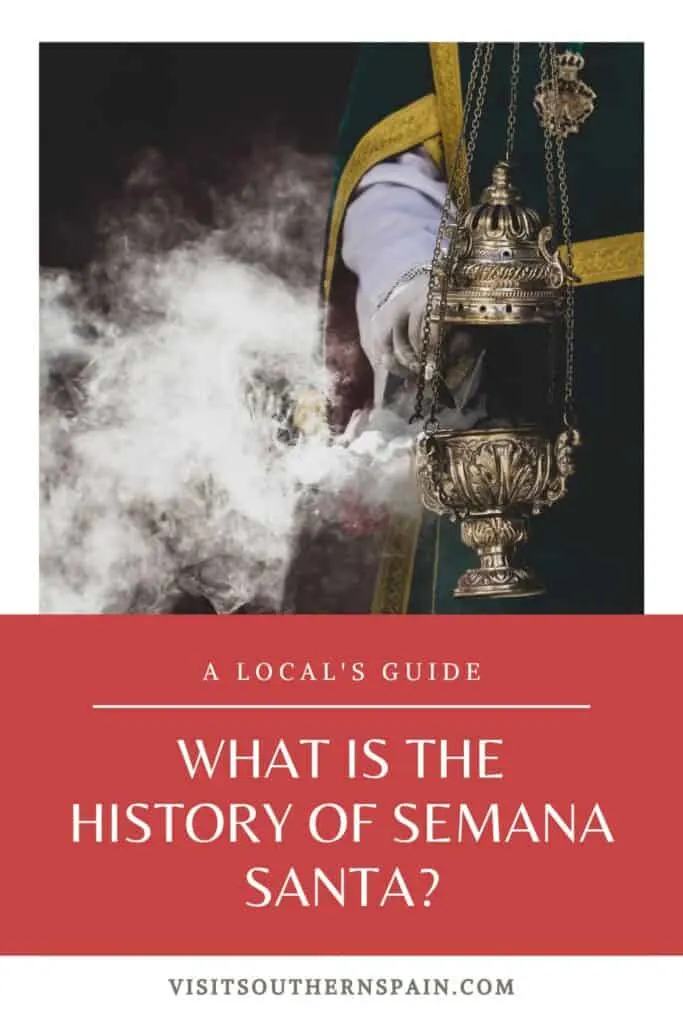A guide to help you learn about what is the history of Semana Santa
If you’re thinking of heading to Spain during the Spring, you should know all about the Semana Santa festival, which is celebrated at this time of year across the nation.
But what is the history of Semana Santa? And why is it such a significant celebration?
We’ll also examine the history of La Semana Santa so you can be well-informed before you take your next trip to spend Easter Week in Spain.
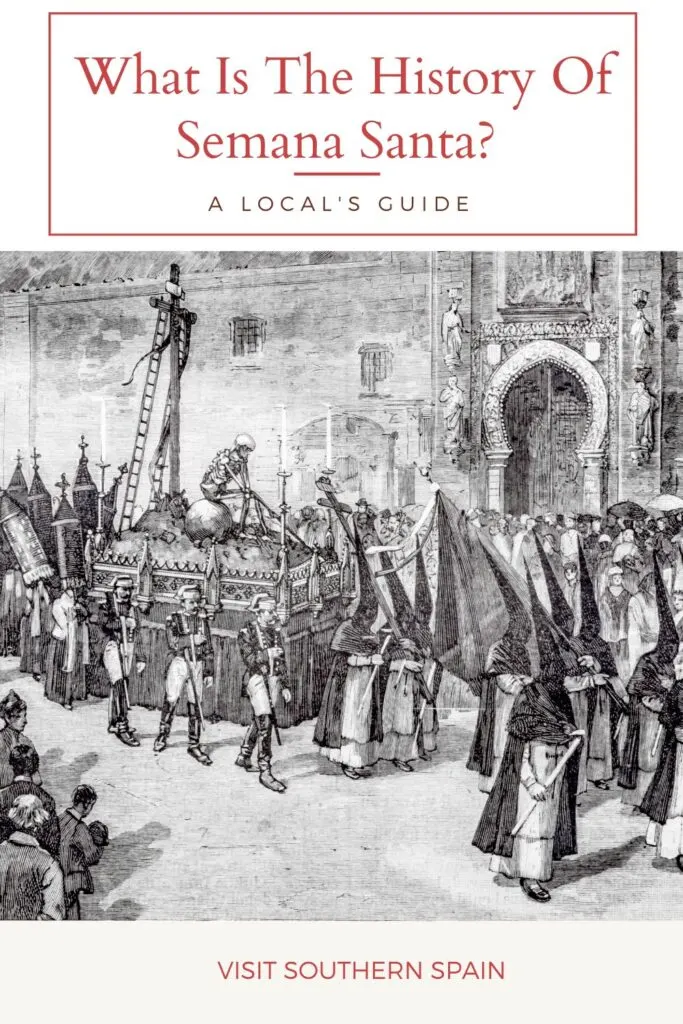
You, dear reader, support this blog. If you purchase through a link, we earn a small commission. As an Amazon Affiliate, we earn from qualifying purchases.
Pssst…!!?? You can’t get enough of Southern Spain guides? Have a look at my other posts:
What Is The History Of Semana Santa
So, are you ready to find out more facts what is the history of Semana Santa?
Here, we’ll answer all your questions, such as “where is Semana Santa celebrated in Spain”, “Why is Semana Santa important?” and “How is Semana Santa celebrated in Spain?”
1. Origins and Early Observances
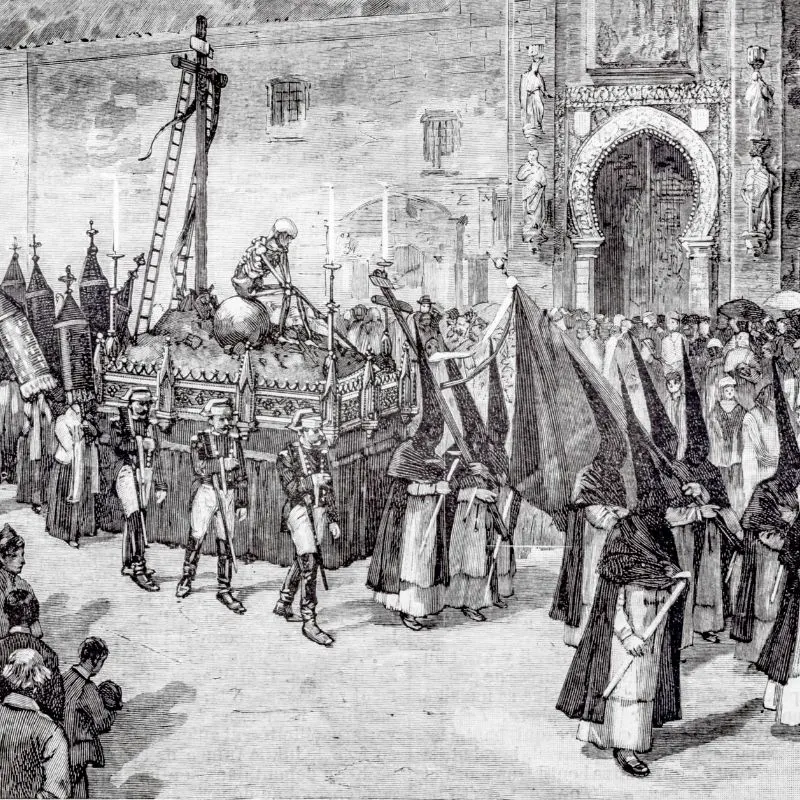
“Semana Santa” in Spain means Holy Week, and it refers to how they celebrate Easter in Seville and, indeed, in other parts of the country too.
Semana Santa in Spain is a religious and cultural holiday, and it involves processions, parades, and celebrations that have a long history and heritage.
The religious meaning of Semana Santa is held dear throughout Spain, with many people of all ages remaining passionate about their Semana Santa traditions.
Although Easter festivals in Spain are customary, the South of the country is especially dedicated to its ancient customs, and so one of the best festivals in Andalucia is Semana Santa.
So, what is the history of Semana Santa? The traditional celebrations of Holy Week in Spain date back to the Middle Ages.
La Semana Santa in Spain has been celebrated in its current form since the 1500s.
Many of the elements seen during Easter in Andalucia date back centuries to a time when the Roman Catholic Church established the tradition of carrying out processions to explain the Easter story to the people.
For centuries, the Catholic church held rituals and masses to mark the celebration of Easter.
During Medieval times, Christians congregated together at Easter to show their respects to Jesus and his Passion.
In those days, different neighborhood Parishes would be led by priests to show devotion to different images representing saints.
Often, statues of a church’s patron saint would either be crafted by local artisans who would then donate them to their church or commissioned by one of the religious brotherhoods or cofradias who would raise the money to cover the cost.
Over time, artisans would adopt their own specific saint to represent their physical condition or job.
The statues that were created to venerate those saints would offer protection and security to those who prayed to them, particularly in times of war, drought, illness, or other kinds of trouble.
One ritual that evolved over time was the “via crucis” or “stations of the cross” – a set of 14 different events based on Jesus’ road to Calvary.
Even today, Catholics adhere to this tradition, either in church or on a larger scale in towns, as happens in Spain.
When the Crusaders returned from Jerusalem, they brought the “via crucis” cult with them. As a result, processions during Holy Week became standard practice.
Part of the Easter celebration involved showing penitence for sins, and during Medieval times, monks would walk through the city streets during Holy Week and “self-flagellate” or whip themselves as a way to repent.
Some lay people began to copy them, and thus, penitent brotherhoods formed amongst the local craft guilds, who would join in with this Eastertime penance.
At this time, the church was also keen to help demonstrate to the people the meaning of Easter in a way that they could understand and engage with.
To that end, they established Passion Plays and Parades that would showcase various elements of the Easter story.
Thus, the Spanish Easter Procession as we know it today was born.
2. Semana Santa during the Spanish Inquisition
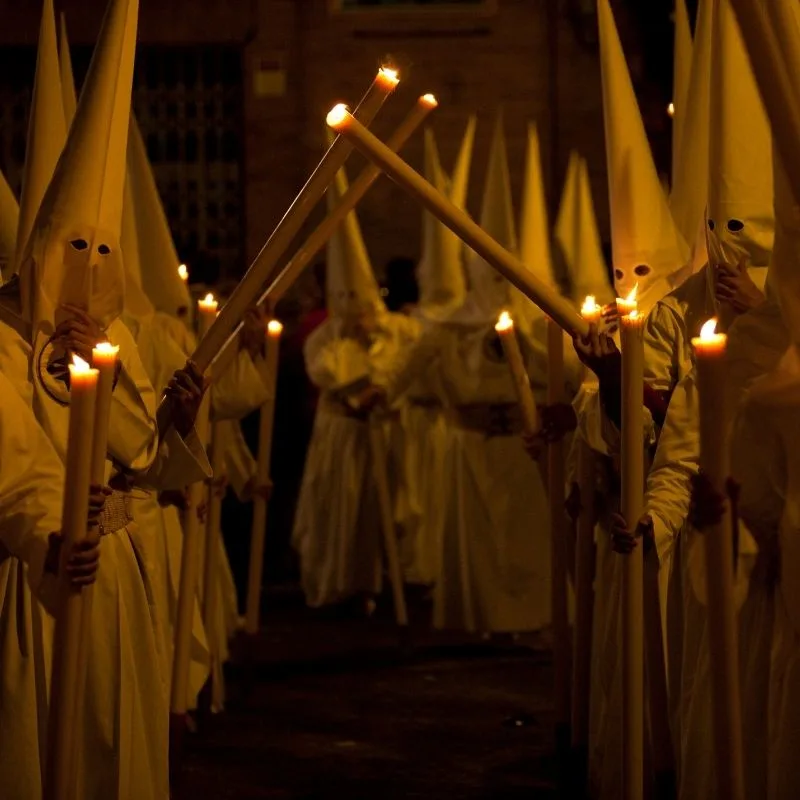
What is the history of Semana Santa and what’s the impact of the Inquisition?
For example, the pointed, conical-shaped hats that are worn during Easter Week in Seville and other Andalucian cities have their origins in the Inquisition.
Those who were required to show penance for their sins in public were forced to wear conical hats to mark them out from the crowd.
The Spanish Inquisition began during the 15th century and continued until the early 1800s.
During this time, there was a strong emphasis on Catholicism, resulting in a renewed religious fervor and a move towards more visual demonstrations of faith.
It was in 1448, just before the Inquisition began that the church had given Franciscan monks in Seville permission to form their own flagellant brotherhood or Hermandad.
In the early years of the Inquisition, in 1487, they then approved a similar brotherhood in Malaga as a way to re-catholicize the city as it recovered from Islamic domination.
Thanks to the improvement in the Spanish economy due to its New World expansion, there was more money available to create ever-more dramatic celebrations to mark religious occasions, and thus, the Easter processions became increasingly impressive.
More Cofradias were formed with lay people processing in masks, bearing crosses that were on fire.
Rapidly, the cult of processions grew amongst the many guilds in the cities, and more and more money was being spent on Semana Santa festivities – something which did not please the church authorities.
In the early 1600s, the church decided to try to control and organize the practice of Easter processions and licenced Cofradias so that they would have specifically controlled routes and times.
This kind of organization continues today.
Despite attempts to ban guild-based Cofradias in 1783, allowing only the religious orders to carry out processions, the practice continued and was widespread once more within a couple of decades.
The 1800s saw a decline in processions because of many traumatic events that affected the country, including famines, plagues, and environmental disasters, as well as political upheaval and the Napoleonic Wars.
Yet the tradition still remained strong in the hearts and minds of the people, and by the century’s end, the practice was revived, only to be once more subjected to upheaval during the time of civil war.
1921 saw General Franco promoting the reinstatement of the Cofradias and the Semana Santa celebrations as a way to express Catholic feelings.
The practice has continued to grow and develop as time has gone on, and today, it is both a national institution and a tourist attraction.
3. Evolution of Processions and Iconography
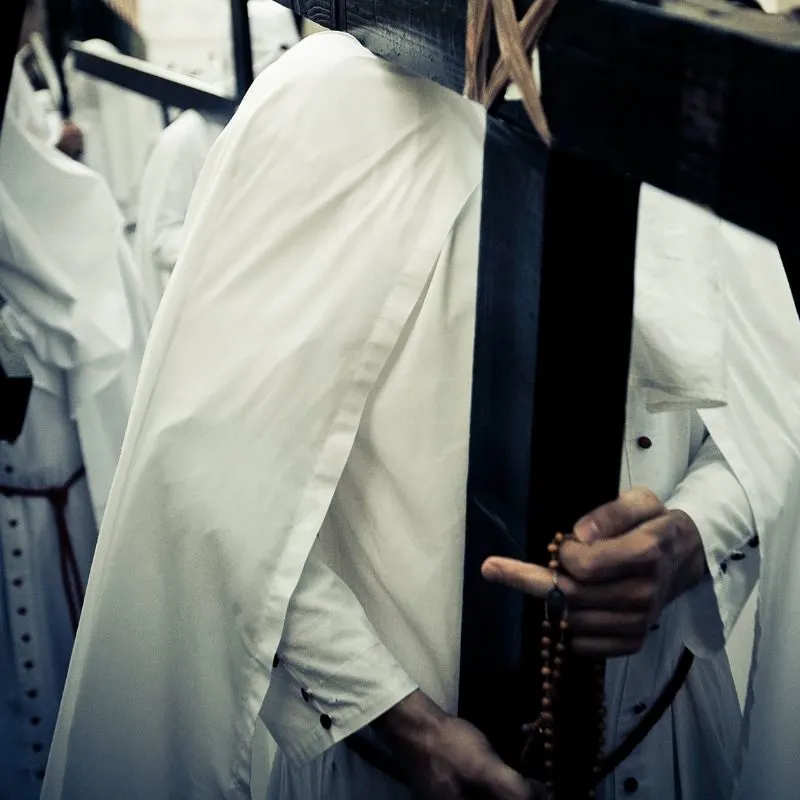
One of the key elements regarding what is the history of semana santa is its religious floats or pasos, which parade through the streets of participating cities and towns, often for several hours.
These floats were born from the original statues that were created during the Middle Ages and kept in various churches.
As the cult of processions and the stations of the cross took hold, the statues developed into impressively decorated floats that would be carried around the neighborhood, and often to the cathedral before returning to their place of origin.
Each paso belongs to a different brotherhood and represents a specific element of the Easter story.
Many of them are centuries old and they are elaborate, beautiful, and carefully carved. They are also exceptionally heavy and require many people to carry them.
The people who carry the floats are known as penitents, and they participate in the processions as their own public penance. Some may even complete the entire procession barefoot.
Some of the participants in the procession are known as Nazarenos. They wear the traditional conical hats with veils to cover their faces, leaving only their eyes on display.
While this headgear is somewhat problematic these days as it conjures up images of the KKK, there is no connection between the two things.
The idea was originally that the Nazarenos would be masked so that they could carry out their penance without any kind of public recognition.
The processions can involve as many as 3000 people, with some involving children.
Crosses are carried as well as candles, which are lit during the evening parades for even more atmospheric impact.
Each city’s Semana Santa celebrations are slightly different and involve different types of artistic expression.
For example, in Seville, there are Saetas, or religious acapella songs, performed at regular intervals.
Music is a key element of the festivities, and it adds even more ambiance to the celebration.
4. Semana Santa in Modern Times
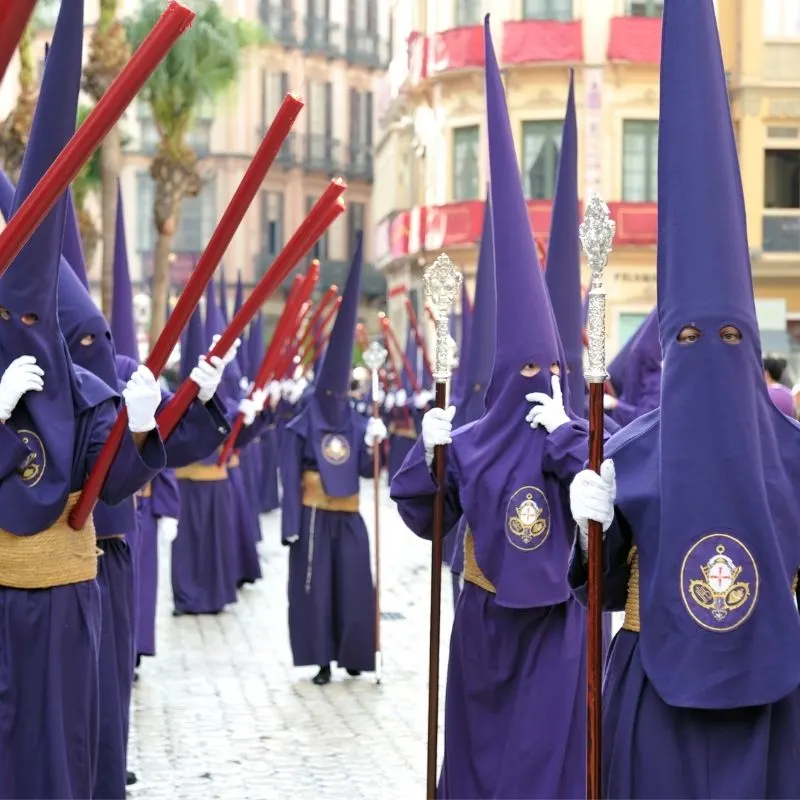
Although only around 18% of people in Spain practice Catholicism regularly, Holy Week in Malaga, Seville, and other parts of Andalucia, and, indeed, the rest of Spain, still sees a lot of participation.
Even those who aren’t devoutly religious value the traditional way that Easter in Granada and the surrounding areas is celebrated and want to play their own part in the festivities.
It is a cultural rather than a religious occasion today.
The Cofradias are really about being a community in the 21st century, and their unique identities, costumes, and floats are a special way to mark that sense of community rather than purely being a religious devotion these days.
Even those who are not religious, and who are not even Spanish immediately think of these dramatic processions and want to be part of the experience.
It’s no surprise that so many people come to spend Easter in Malaga, Spain so that they can sample a taste of the authentic side of Andalucia.
Easter Week in Malaga, Seville, or any of the other major Southern cities is something that every keen traveller should participate in at least once in their lifetimes.
Tourists from all over the world are now asking, “What is the history of Semana Santa?”
They are being drawn to this part of Spain to see for themselves exactly how the Spanish demonstrate their cultural heritage.
It’s clear that not only is Holy Week a culturally and traditionally significant time for the Spanish people, but it’s also an opportunity to achieve greater global recognition and boost tourism – something that is crucial for the nation’s economy.
People come from all over Spain, not to mention from other parts of the world, to eat, drink, stay in local hotels and apartments, and spend their Easter holiday in a setting that still respects its true meaning.
The best places to experience Holy Week in Andalusia
5. Seville: The Epicenter of Semana Santa
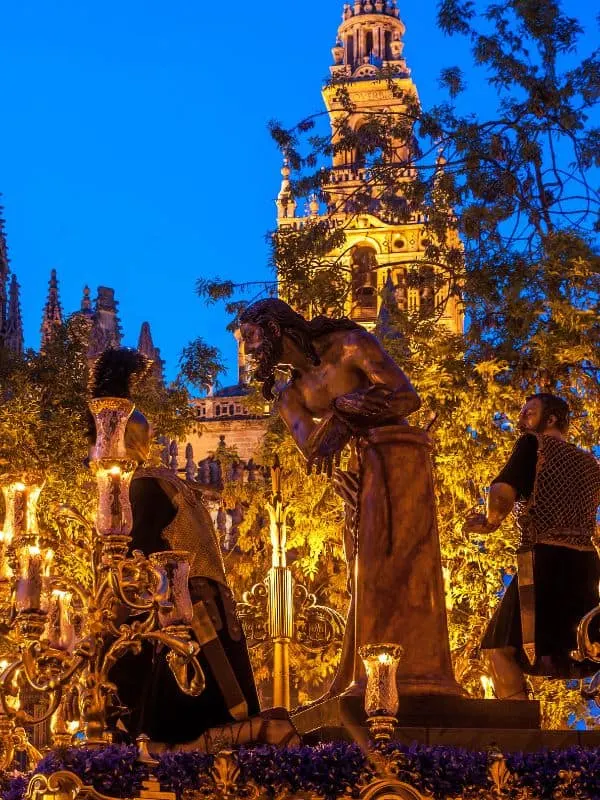
Seville is one of the best places to learn all about what is the history of Semana Santa, thanks to its ancient traditions and floats that date back for centuries.
Here, you’ll see thousands of Nazarenos taking part in the processions, which are so impressively long that they can last for as many as 12 hours, and there are as many as 60 different ones taking place over the week.
Seville is also the place to hear saetas, the traditional religious acapella songs with a flamenco influence, performed from balconies throughout the city’s narrow streets.
Read more about Seville:
- One Day in Seville
- What to See in Seville for First-Timers
- Flamenco Shows in Seville
- Best Places to Stay in Seville
- Family Hotels in Seville
6. Granada: Moorish Influence in Holy Week Celebrations
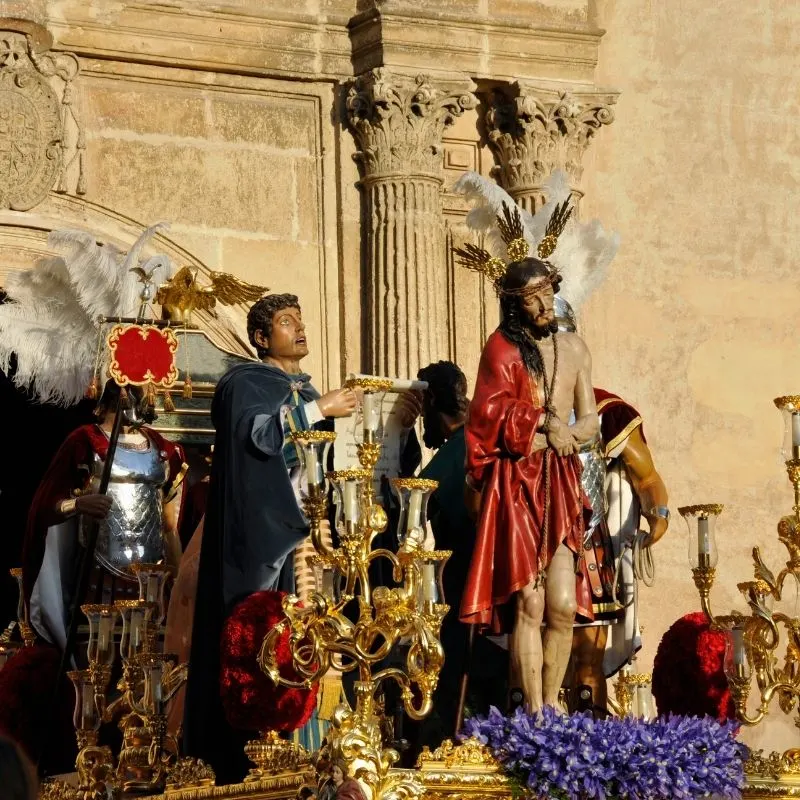
The meaning of what is the history of Semana Santa in Granada is a much simpler experience of Holy Week in Andalucia and is the perfect place to go to experience a unique fusion of Christian and Moorish elements.
Today, there are around 30 different processions, each one paying its own respects at the cathedral before returning to its home church.
There are some unusual elements to Granada’s Semana Santa, however, thanks to its cultural heritage.
For example, the Cristo de los Gitanos procession held on Holy Wednesday which sees the Gypsy parade climbing the Cuesta Chapiz and moving along the bonfire-lit route to Sacromonte Abbey.
Read more about Granada:
- Family Hotels in Granada
- One Day in Granada
- Granada Hotels near Alhambra
- Where to Stay in Granada
- What to Eat in Granada
7. Malaga: Coastal Charms and Passionate Processions
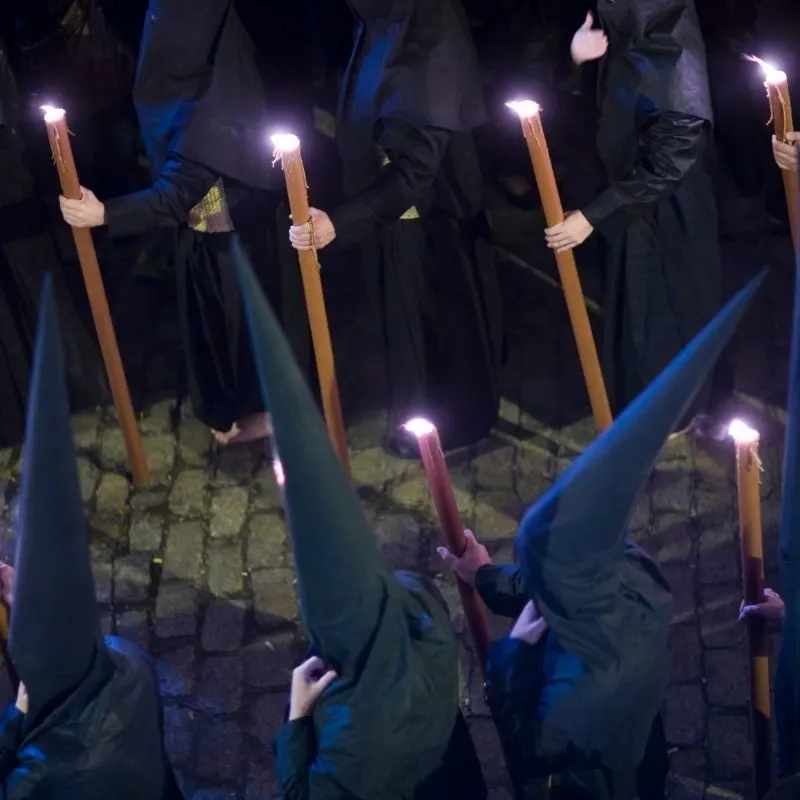
Malaga may be a vibrant coastal resort, best known for its holidaymakers and laidback summer vibes, but during Holy Week, it takes on a completely different aspect.
In the 1960s, Malaga’s Semana Santa was declared to be an event of International Tourism and thousands of people come from all over the world to see the elaborate floats and experience the impressive processions.
What is the history of Semana Santa in Malaga and how is it best celebrated?
There’s no better place to experience the local Easter traditions and to sample some of the finest culinary delights of the season, such as bunuelos de viento, torrijas, and special borrachuelos de Malaga
Read more about Malaga:
- Best Malaga Beach Hotels
- 1 Day in Malaga
- Best Museums in Malaga
- Where to stay in Malaga
- Best Family Hotels in Malaga
- Hotels in Malaga Center
8. Córdoba: Historic Beauty and Spiritual Serenity
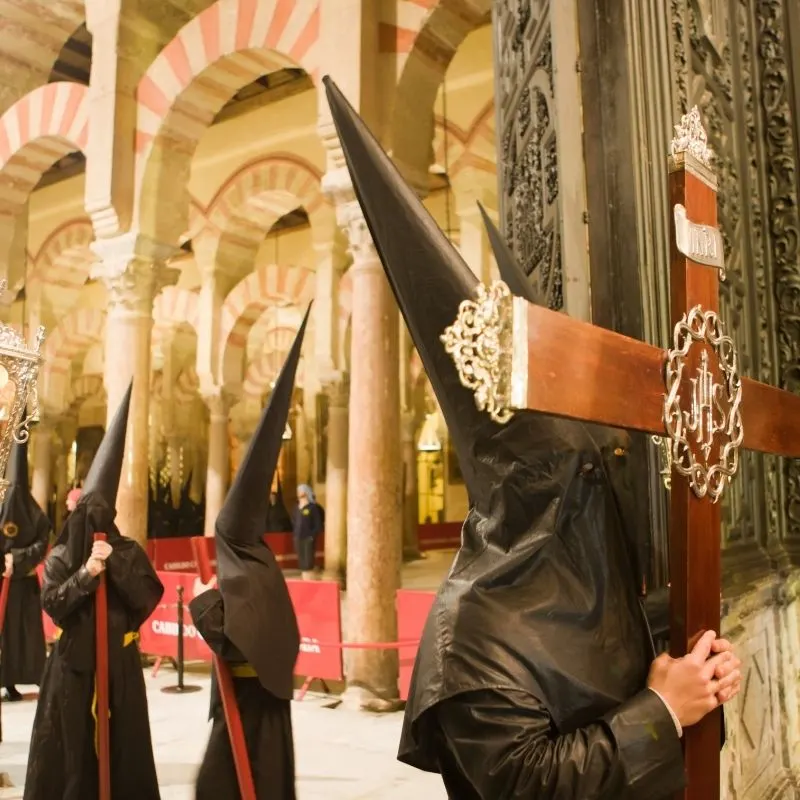
Cordoba’s Holy Week origins date back to Medieval times, with the first street processions taking place during the 1500s.
Today, 38 brotherhoods process around the streets of the city, and its stunning ancient architecture, which has resulted in its winning no less than four different World Heritage Site awards, forms an incomparable backdrop.
The Semana Santa festivities in Cordoba themselves have been given the title of a “Festival of National Tourist Interest,” making them a must-see.
Read more about Cordoba:
9. Jerez de la Frontera: Flamenco, Horses, and Holy Week
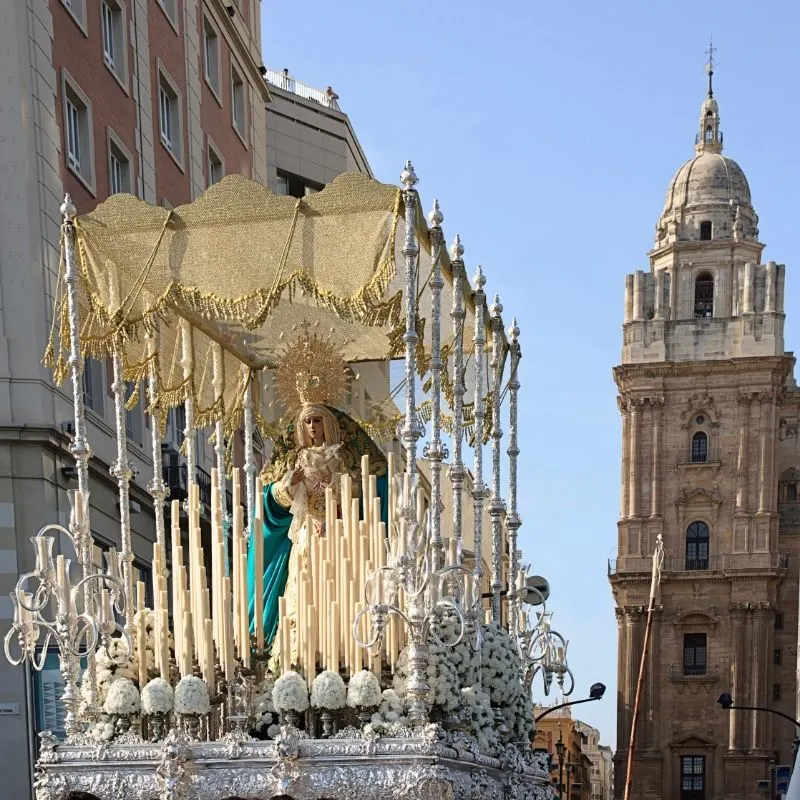
44 brotherhoods take part in Jerez de la Frontera’s Holy Week parades, each one stopping at the city’s cathedral to do penance.
Not only can you experience the dramatic Easter processions in Jerez, but you can also experience many other key events that are unique to this part of Andalucia.
There are Flamenco performances held during this week, along with equestrian processions and horse parades that are truly spectacular to witness.
Related article: Things To Do In Jerez
10. Almería: Historical Heritage Amidst Semana Santa
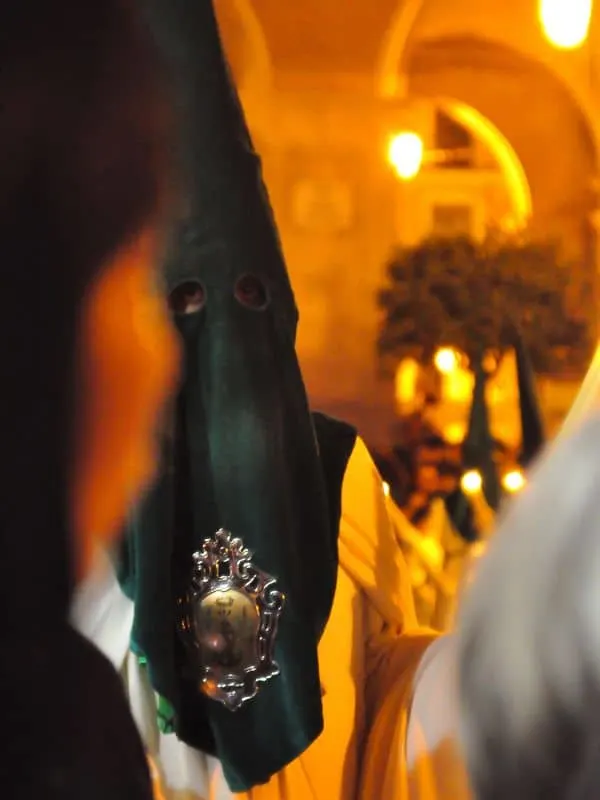
Holy Week in Almeria sees thousands of participants taking part, with one of the most notable being the Via Crucis de Silencio, which is carried out completely silently by lantern light.
The Encounter is another special and iconic moment on Maundy Thursday, which is now held at Plaza Emilio Perez instead of the Alcazaba, where it traditionally took place.
28 processions take place during Easter Week, and they each have their own special place in Almerians’ hearts.
Related articles:
Conclusion on what is the history of Semana Santa
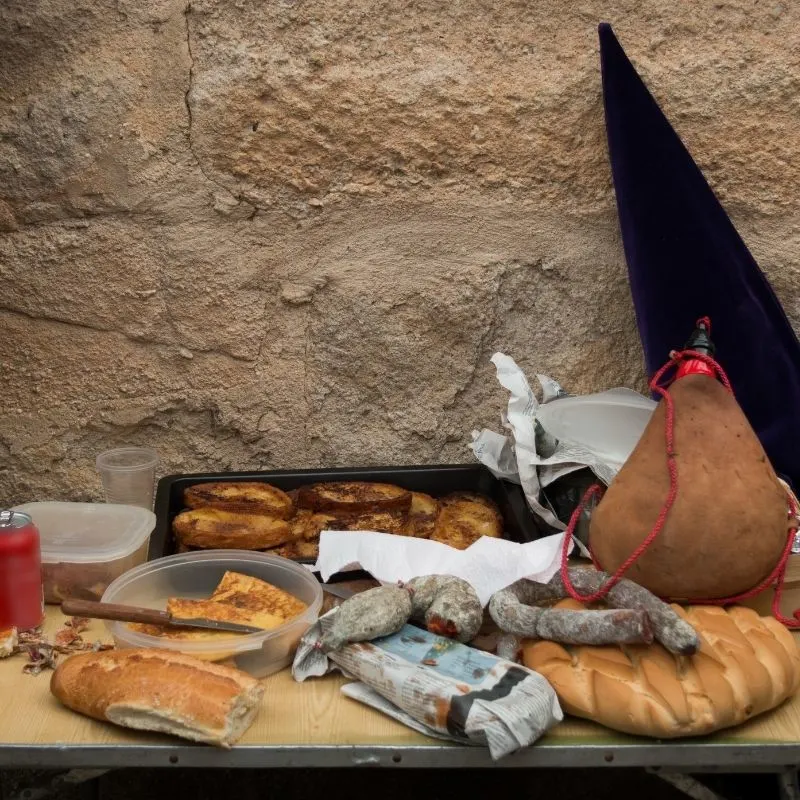
Now you know the answer to the question “What is the history of Semana Santa”.
You’ll have a better understanding of the historical, religious, and cultural significance of Easter week in Andalucia where its rich heritage sees a particularly unique fusion of Moorish and Christian ideologies.
Having evolved over hundreds of years since the Middle Ages, the Semana Santa celebration now takes a format that has been in place since the 1500s.
This holiday is a key event in the calendar not only for the Spanish themselves but also for travelers from all over the world who want to experience the authentic celebration for themselves.
They are eager to appreciate the rich historical and cultural tapestry of Spain’s heritage – a desire that is unlikely to come to an end any time soon.
It seems clear that Semana Santa will continue to be commemorated in this unique way for generations to come.
FAQ about what is the history of Semana Santa
What is the most important day of Semana Santa?
The most important day of Semana Santa is Good Friday.
It is the day of Christ’s death, although the processions to mark the occasion begin during the evening of Maundy Thursday and continue into the early hours of Friday morning.
What is a fun fact about Semana Santa?
If you’re asking the question “When is Semana Santa?” the fun fact is that there is no set date for the celebration.
Easter is a movable feast, so it could be any time between March and the end of April.
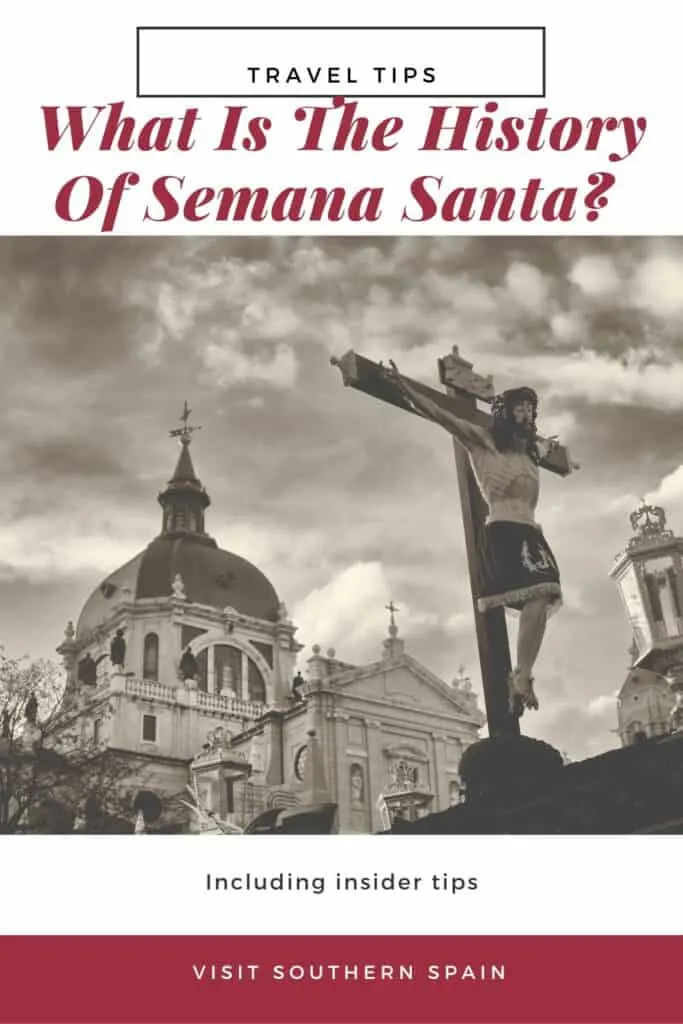
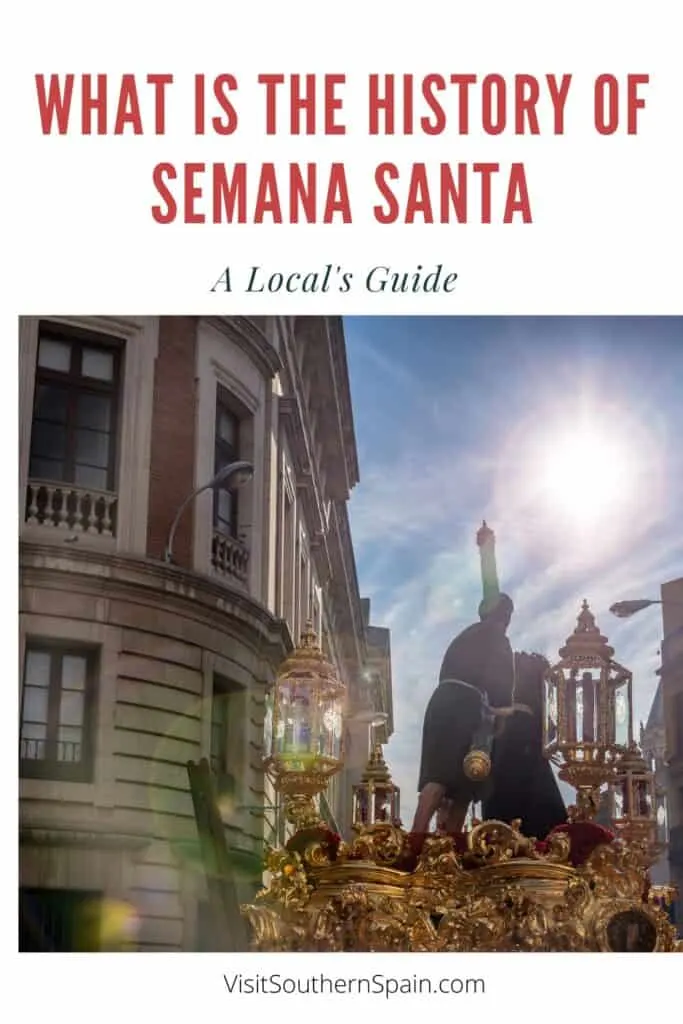
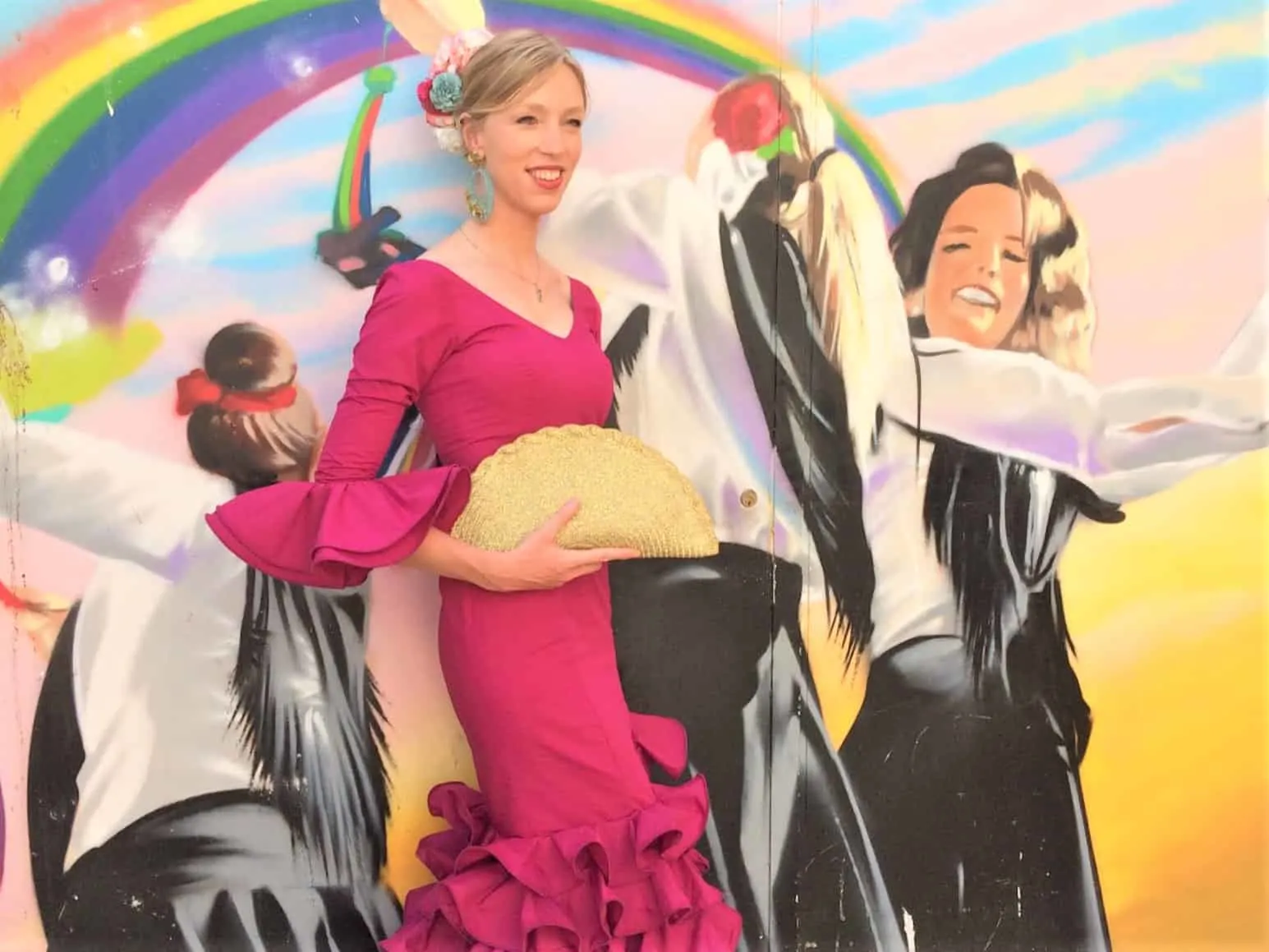
Hola, I’m Paulina! Together with my team, we are passionate about Southern Spain. Here we share all you need to know for great times in Southern Spain with the best places to visit, stay and, of course, the best food to eat.
Let’s dive in and explore Southern Spain’s outdoors, food and culture con pasión!

